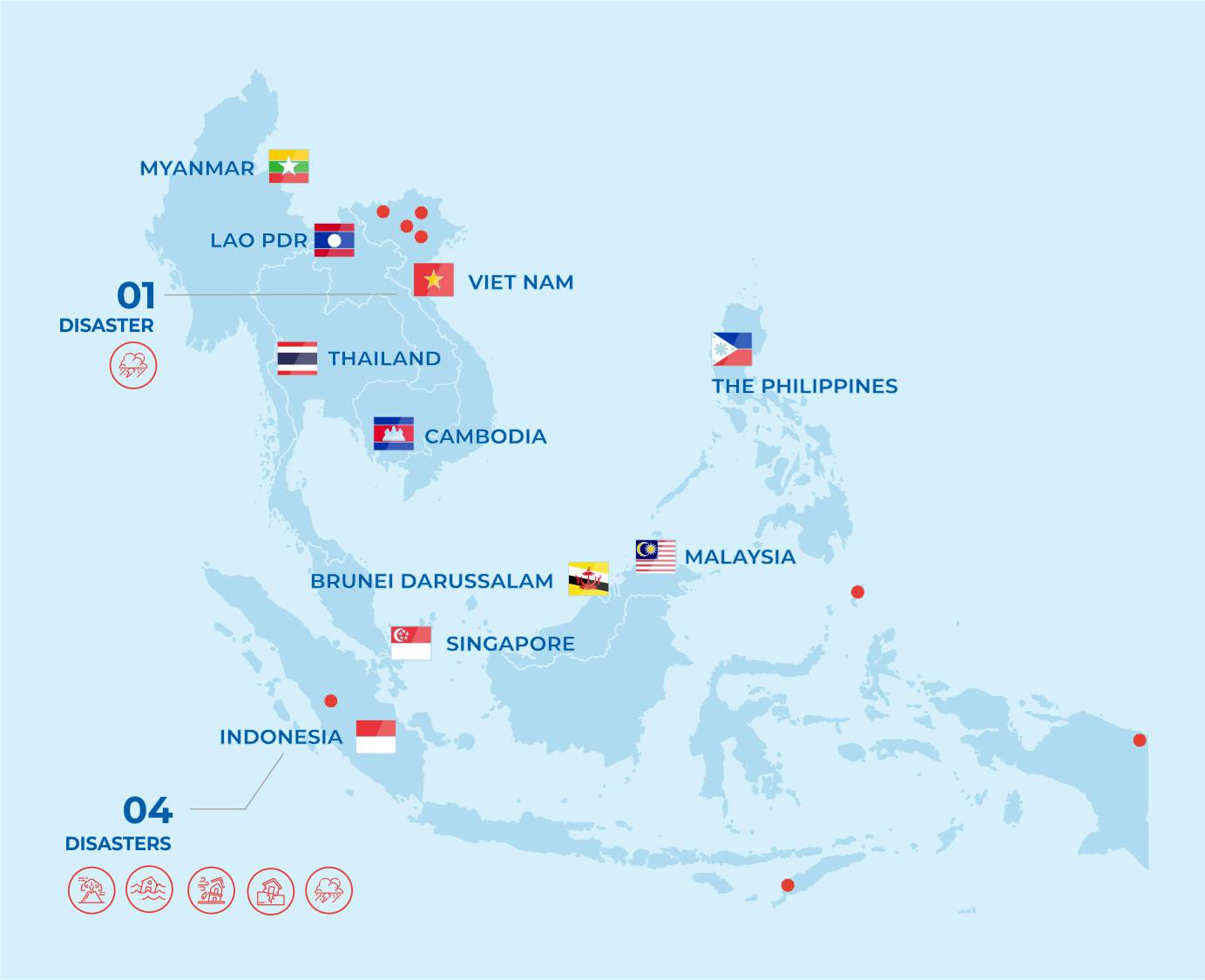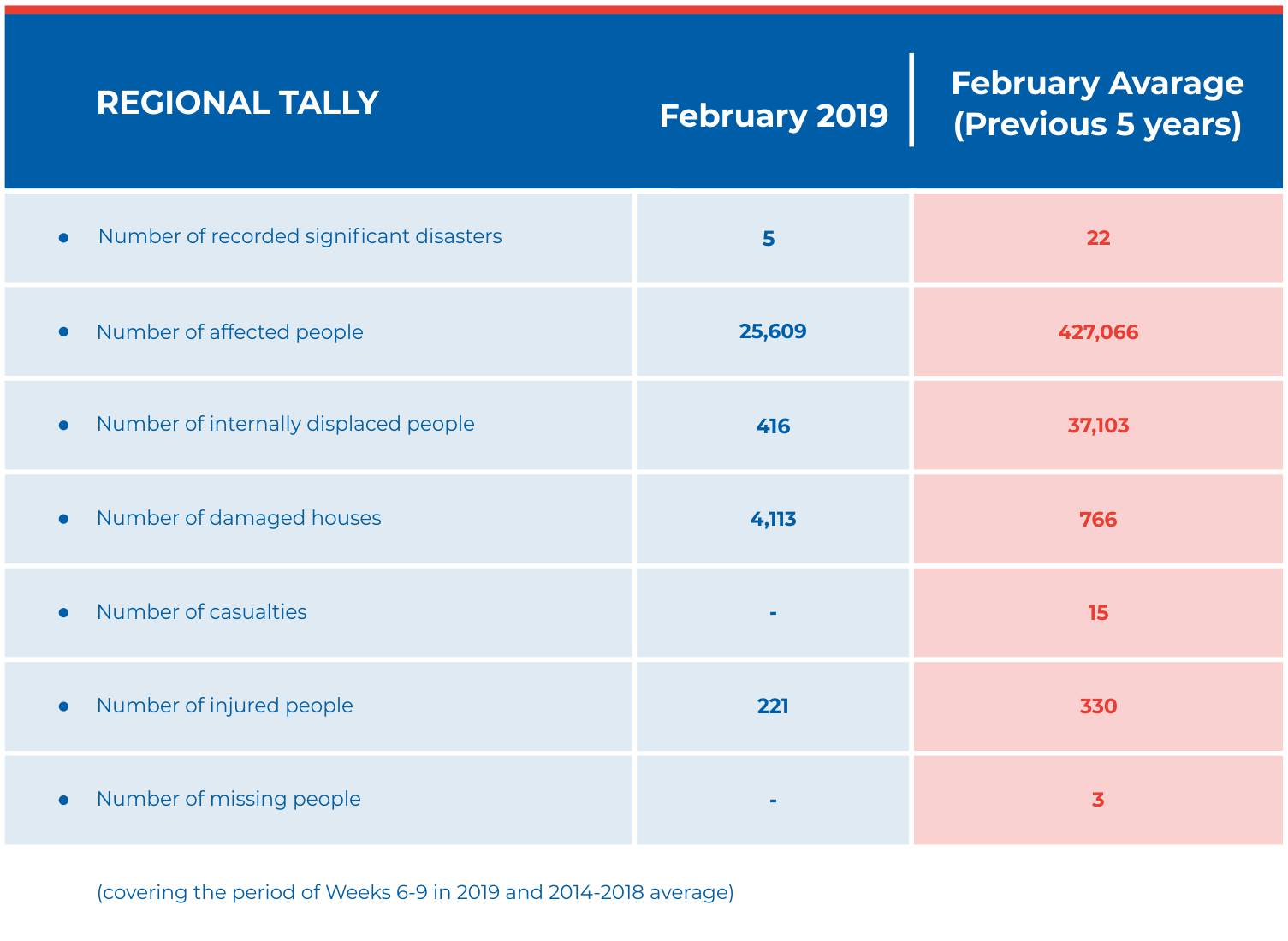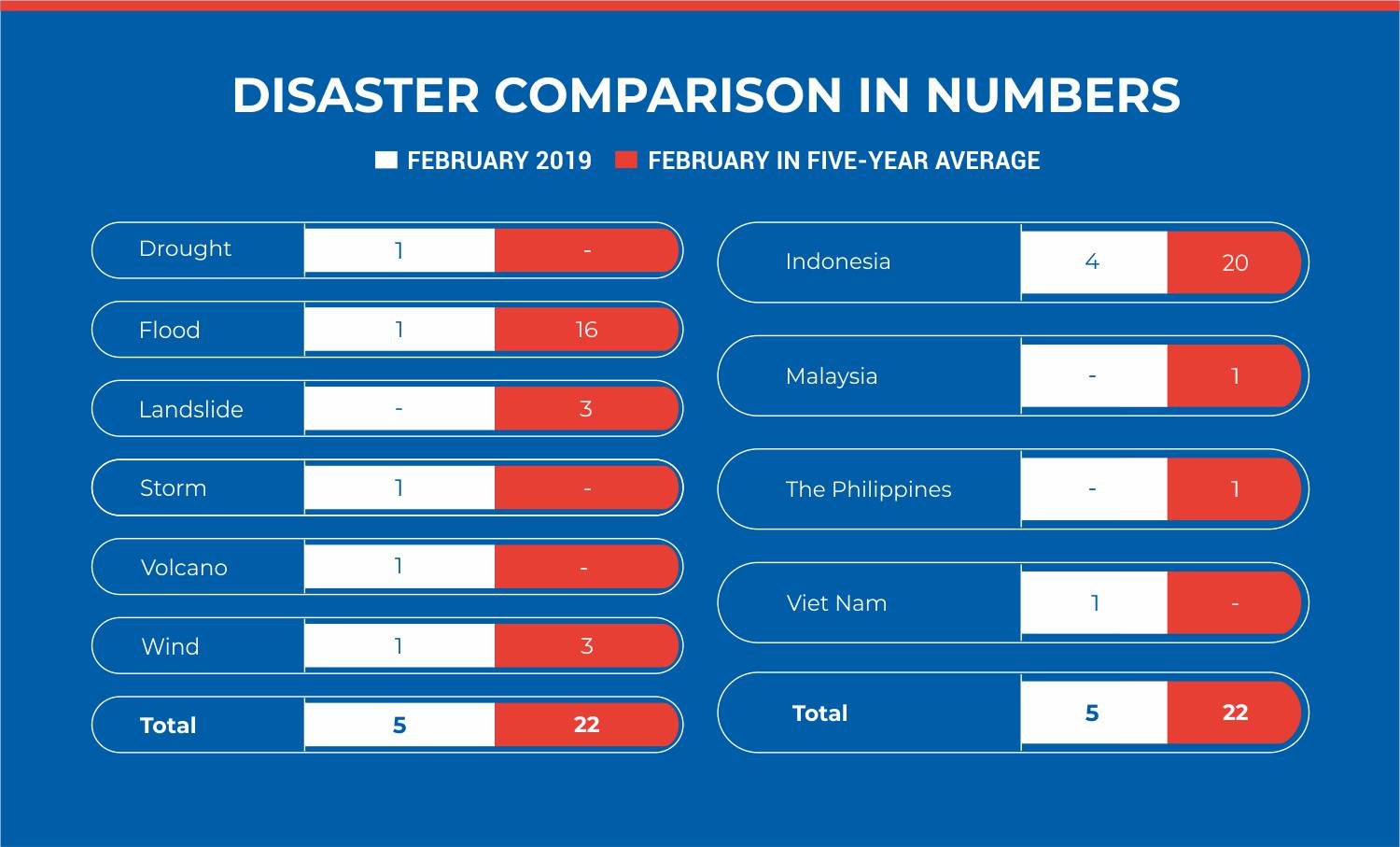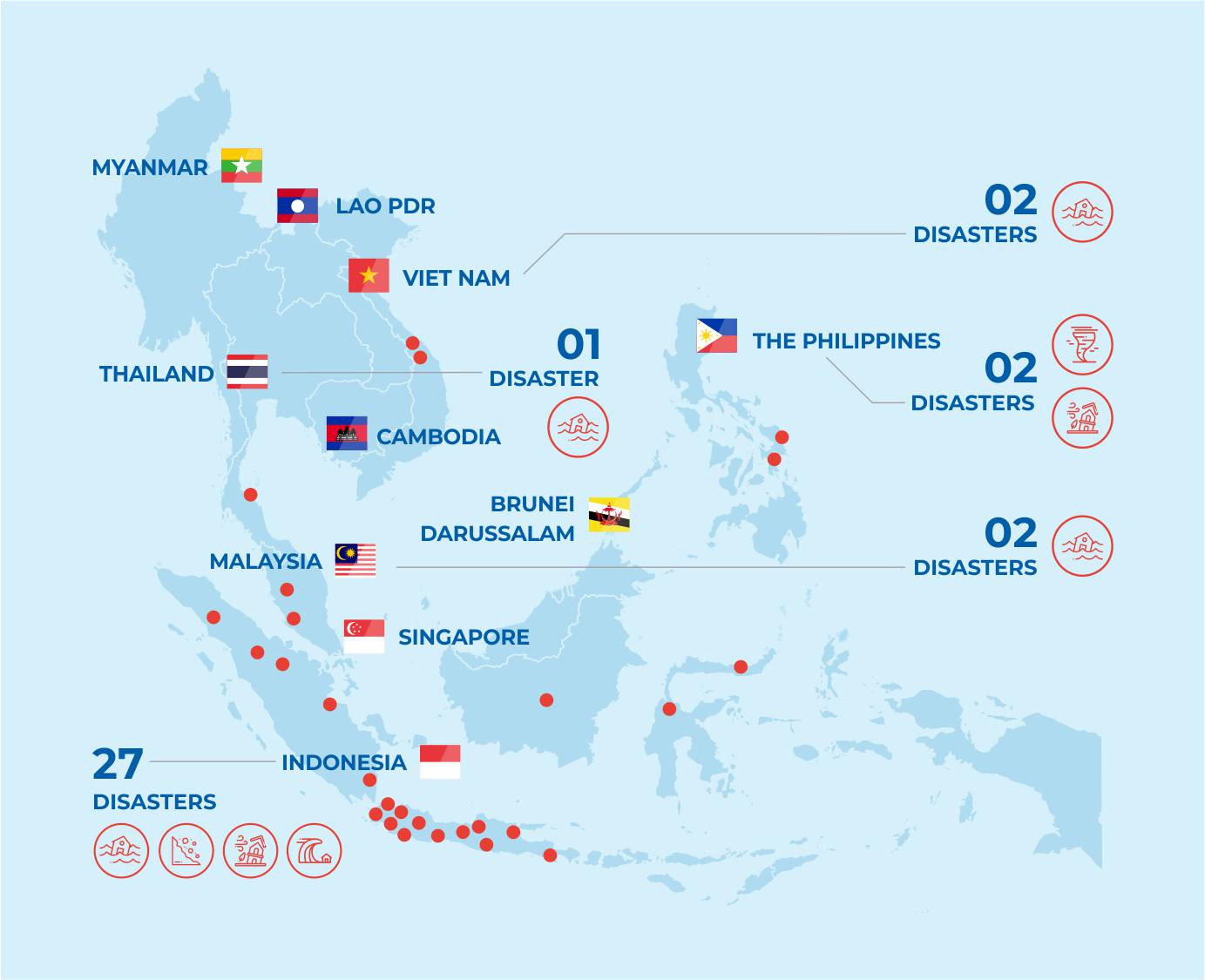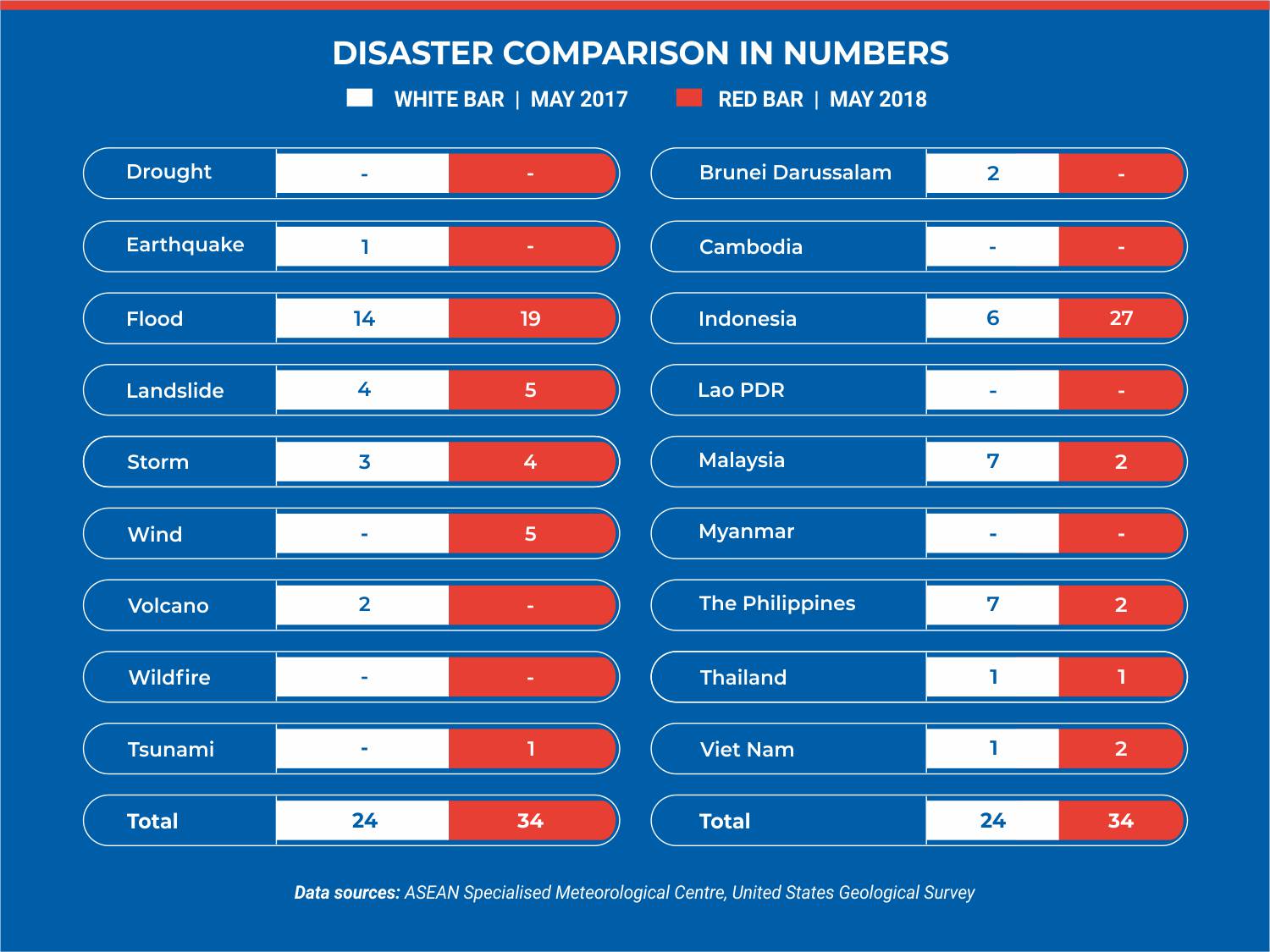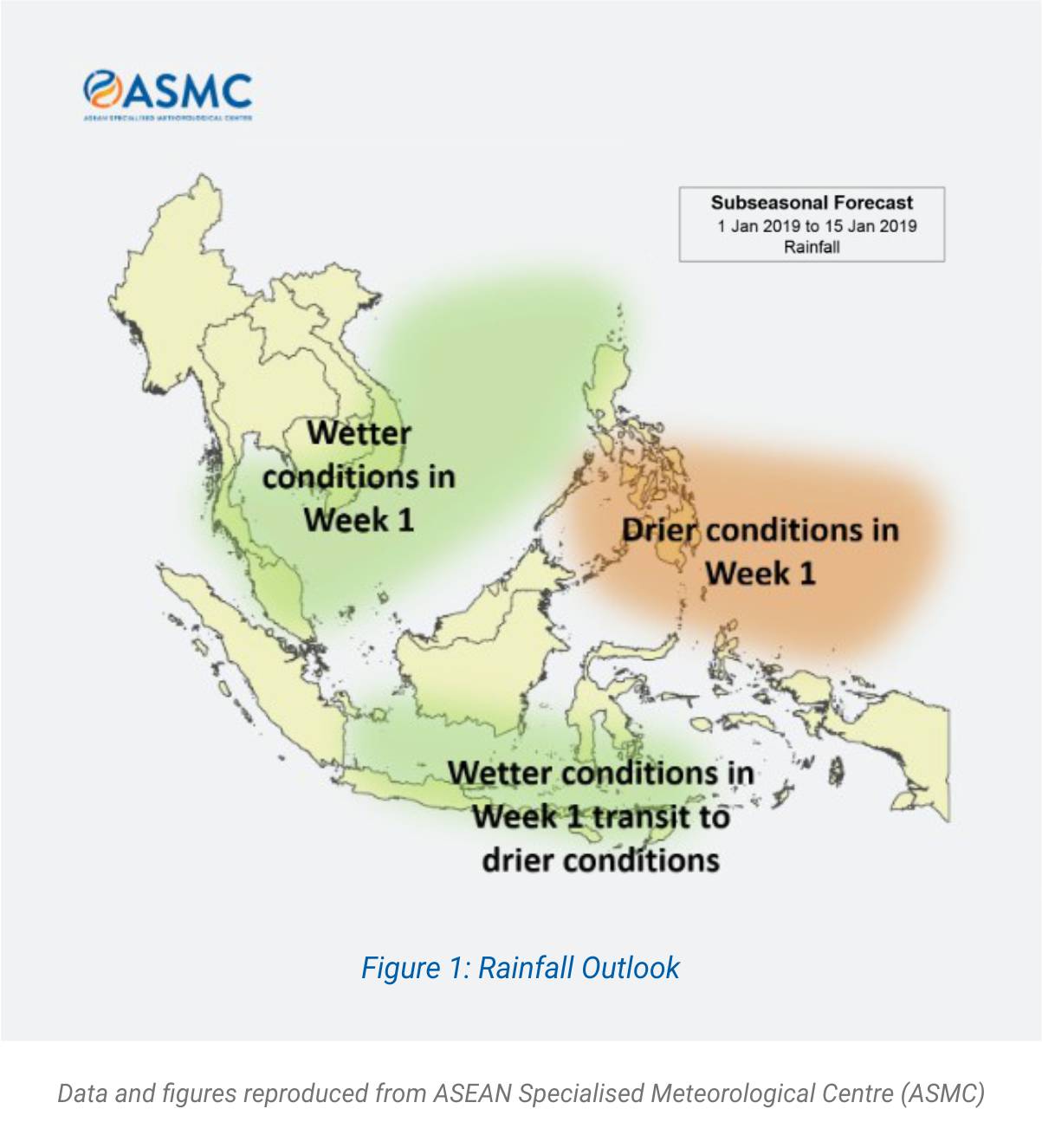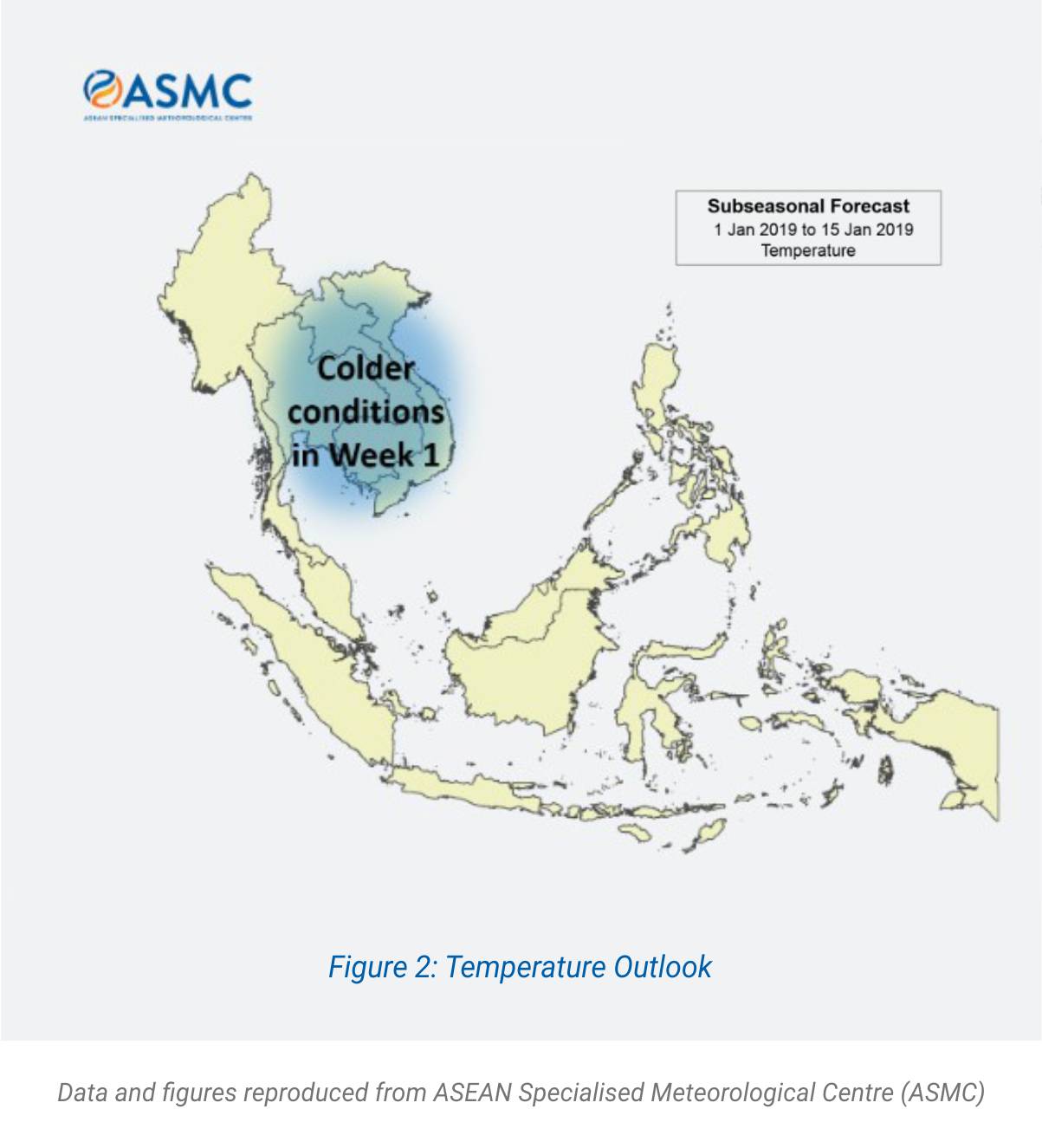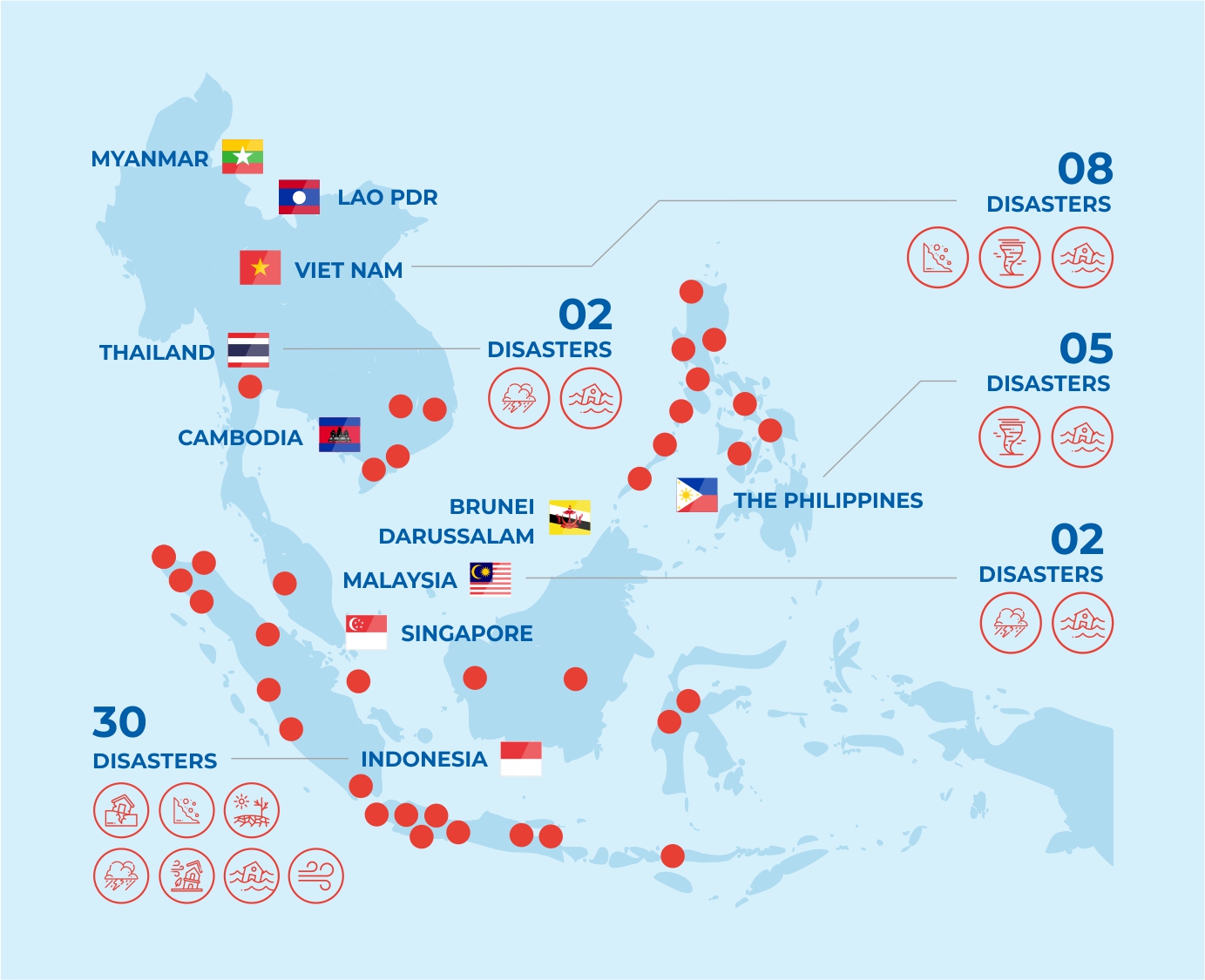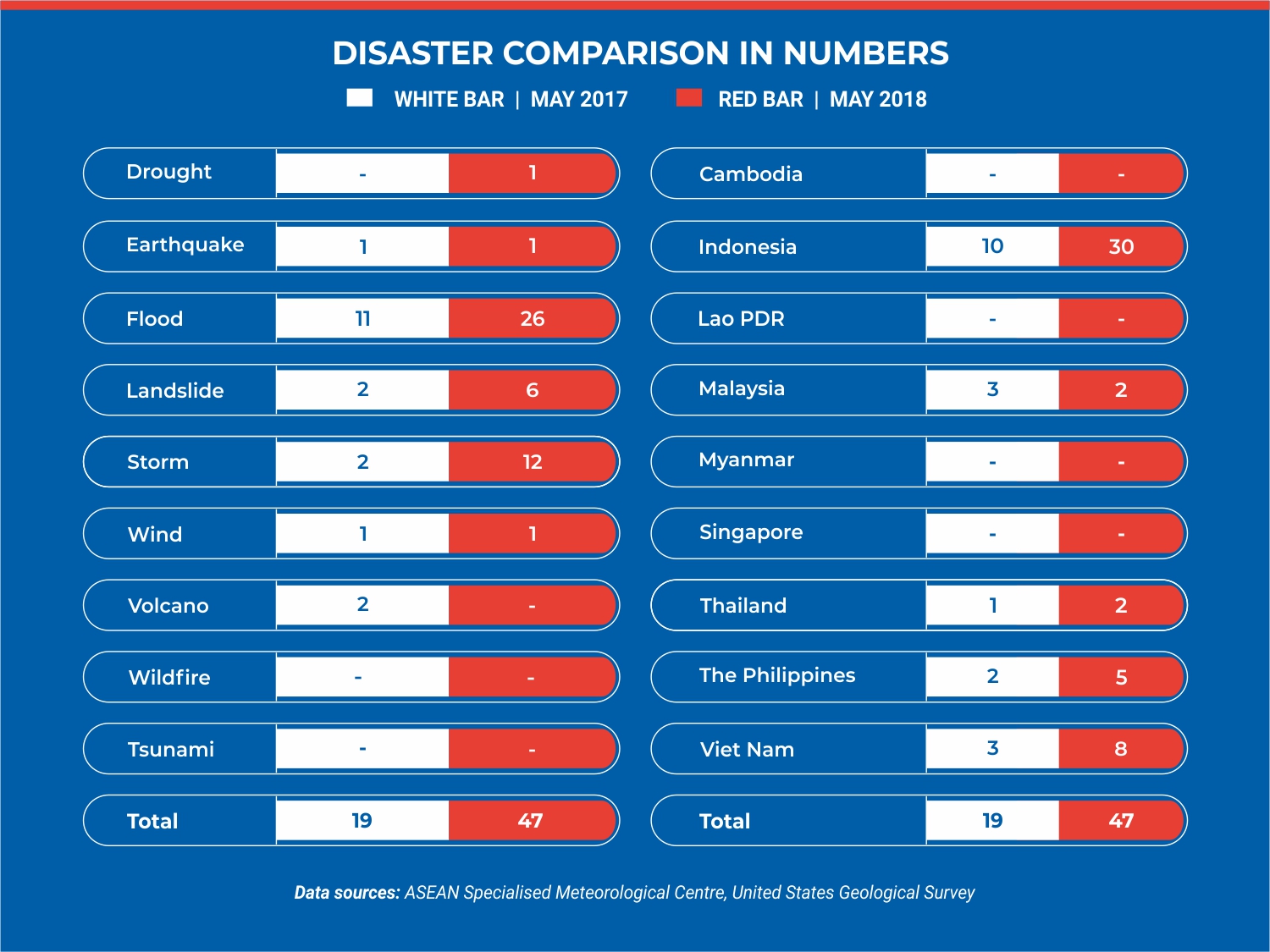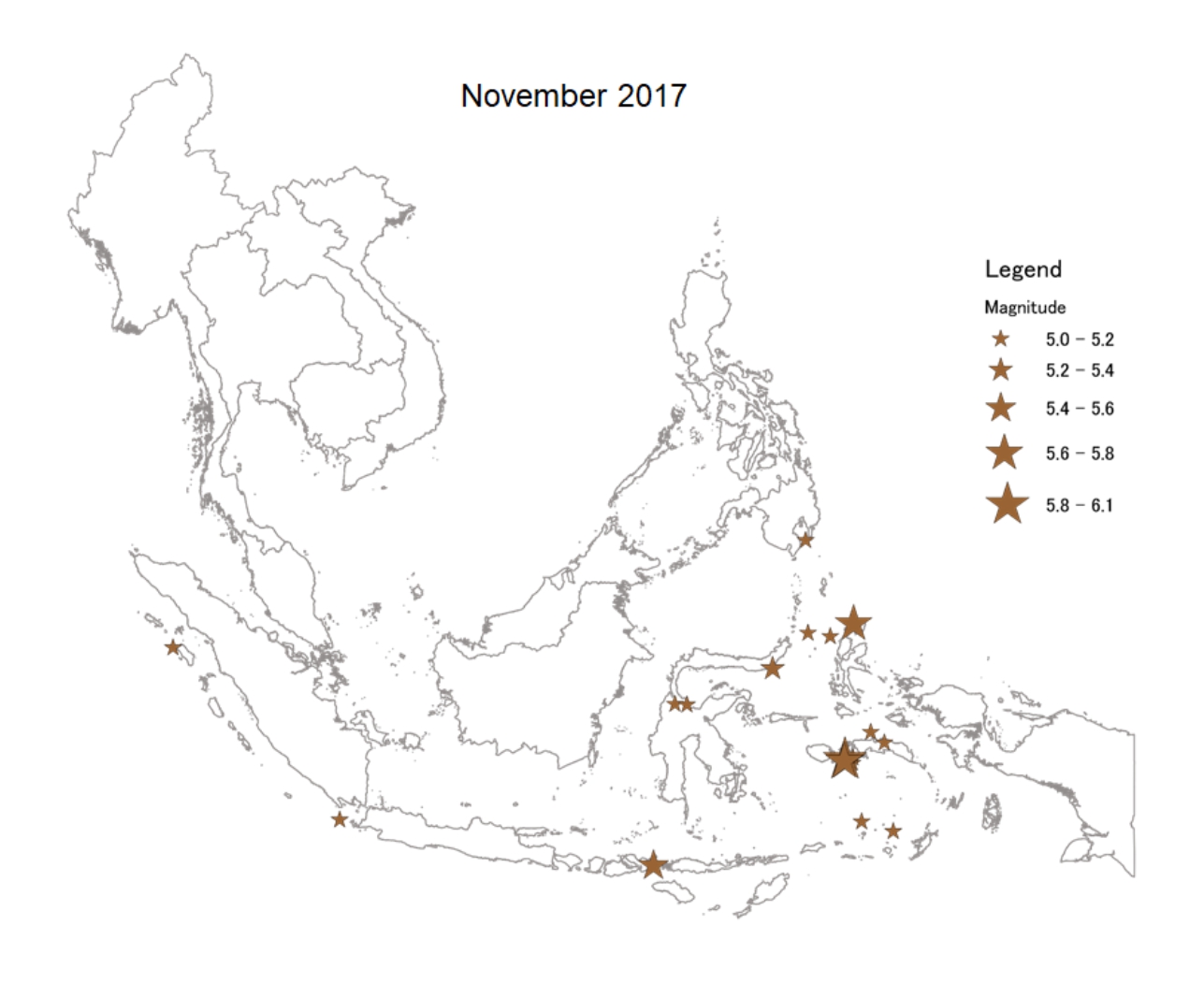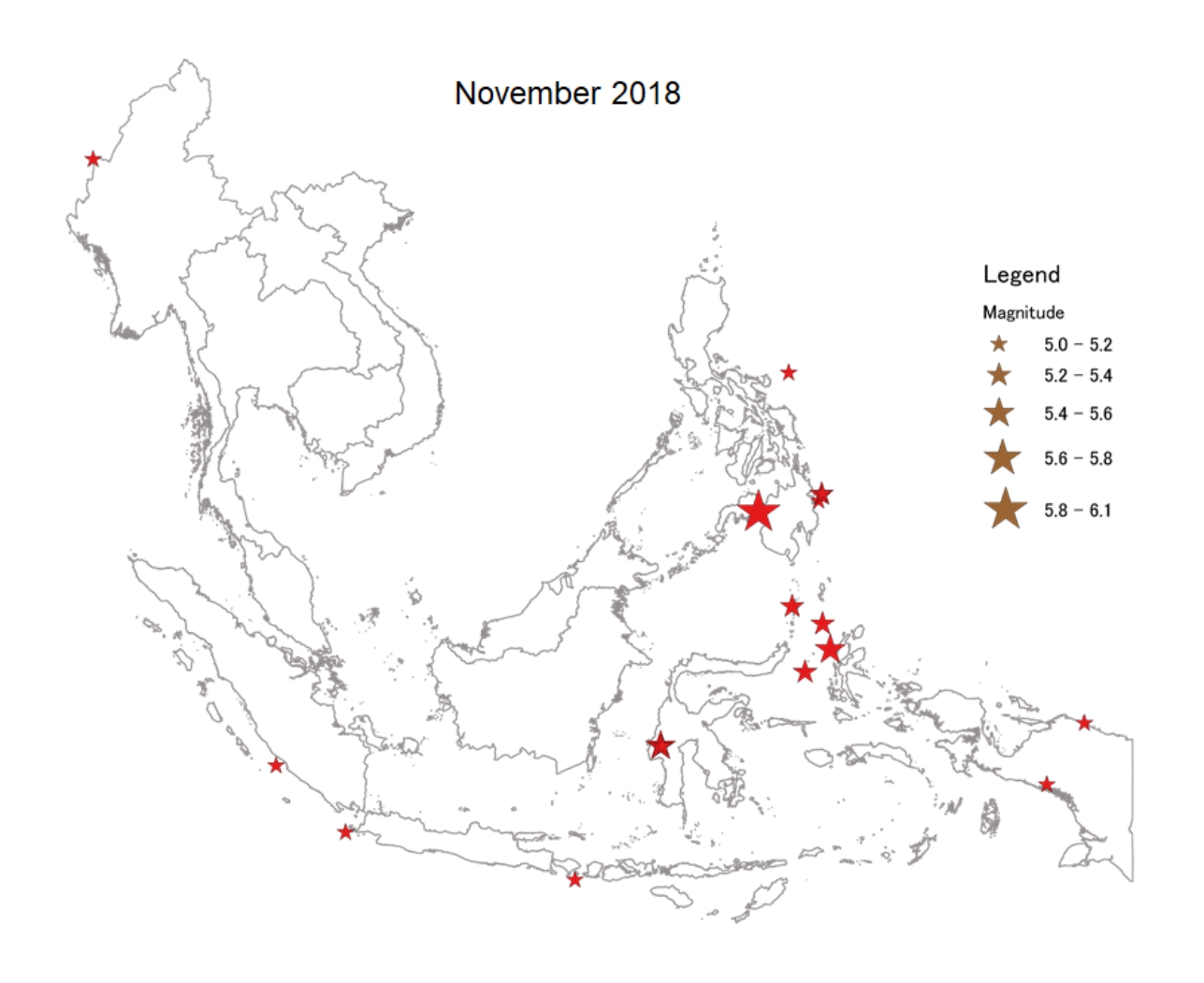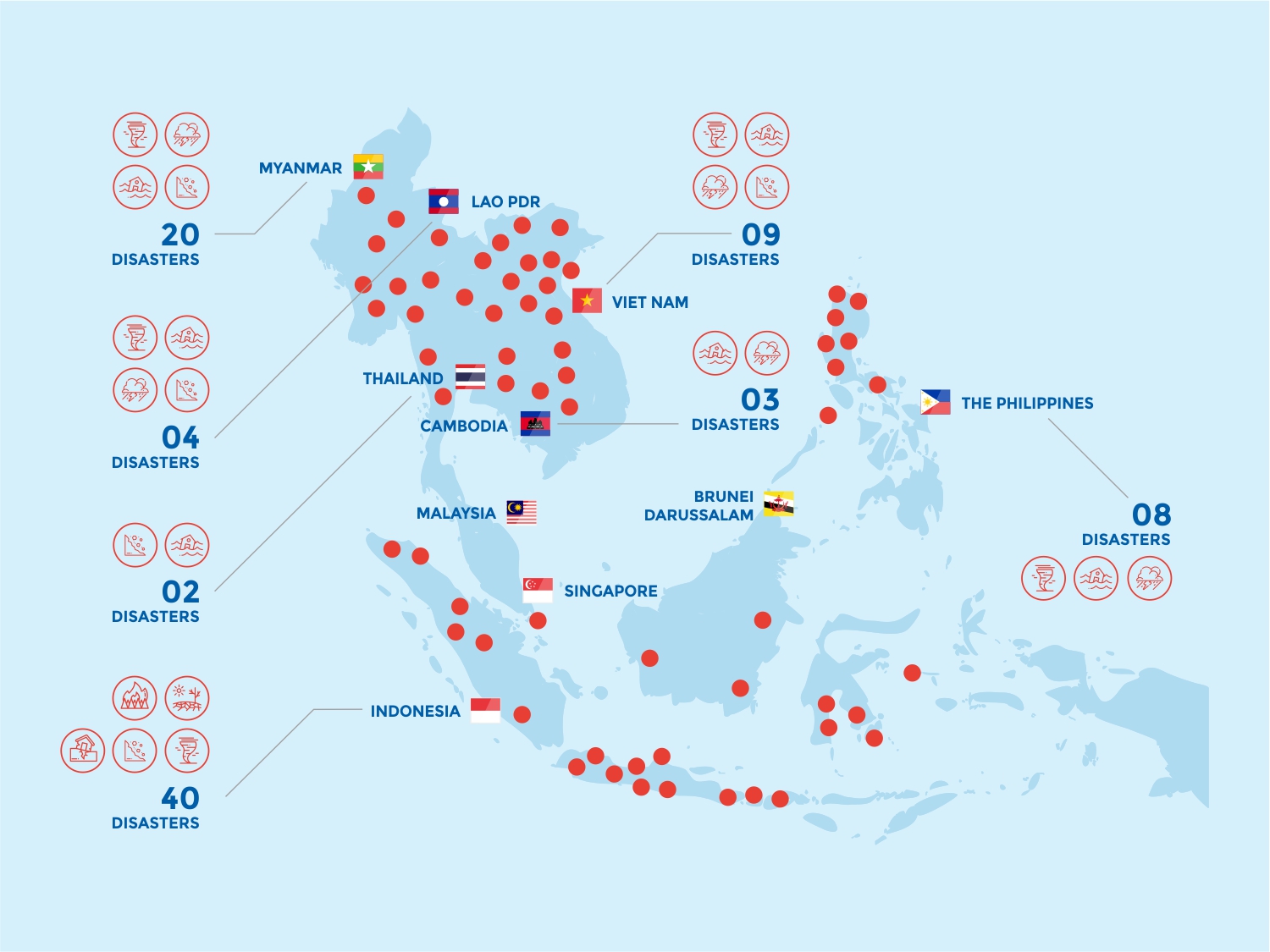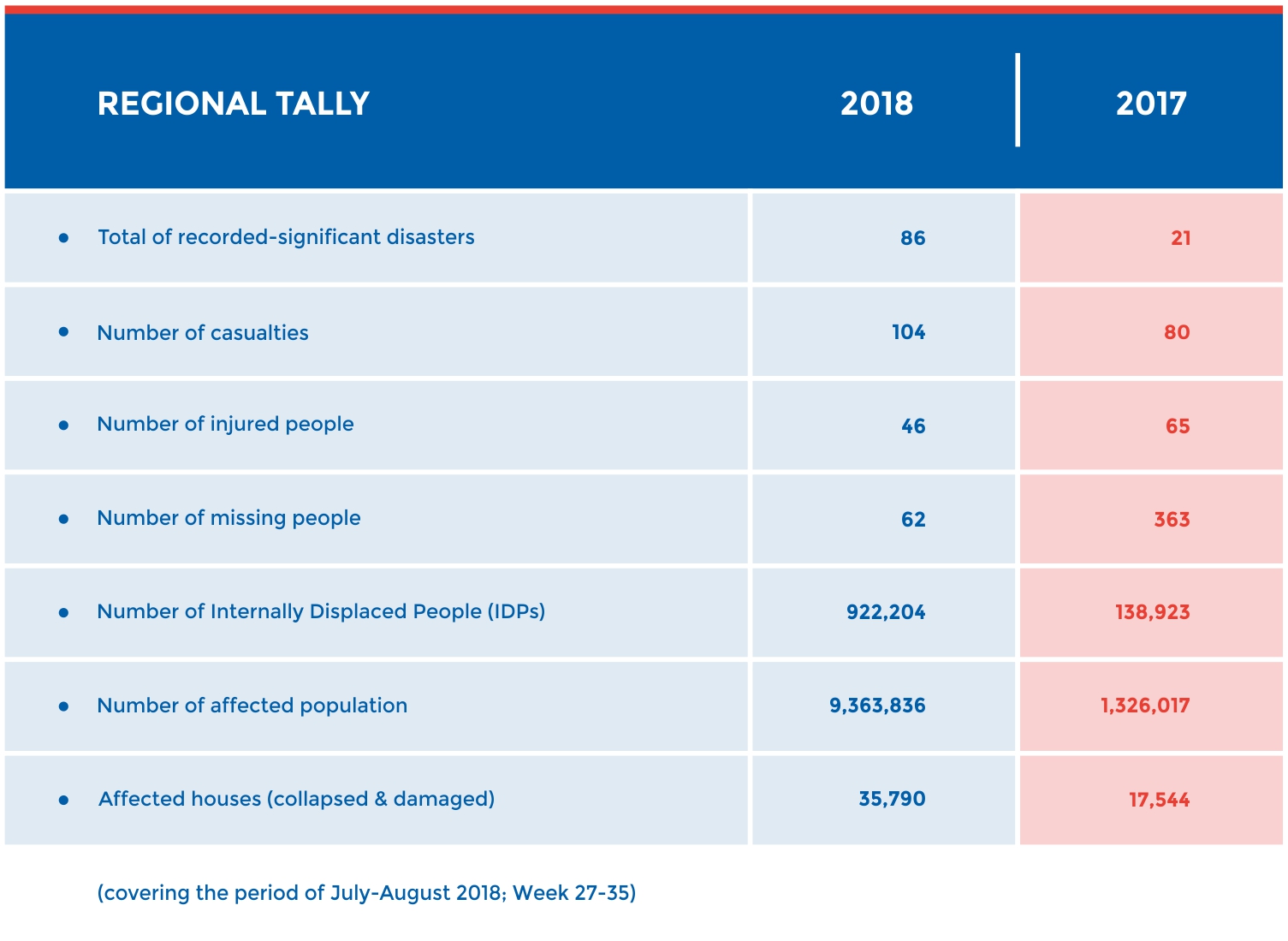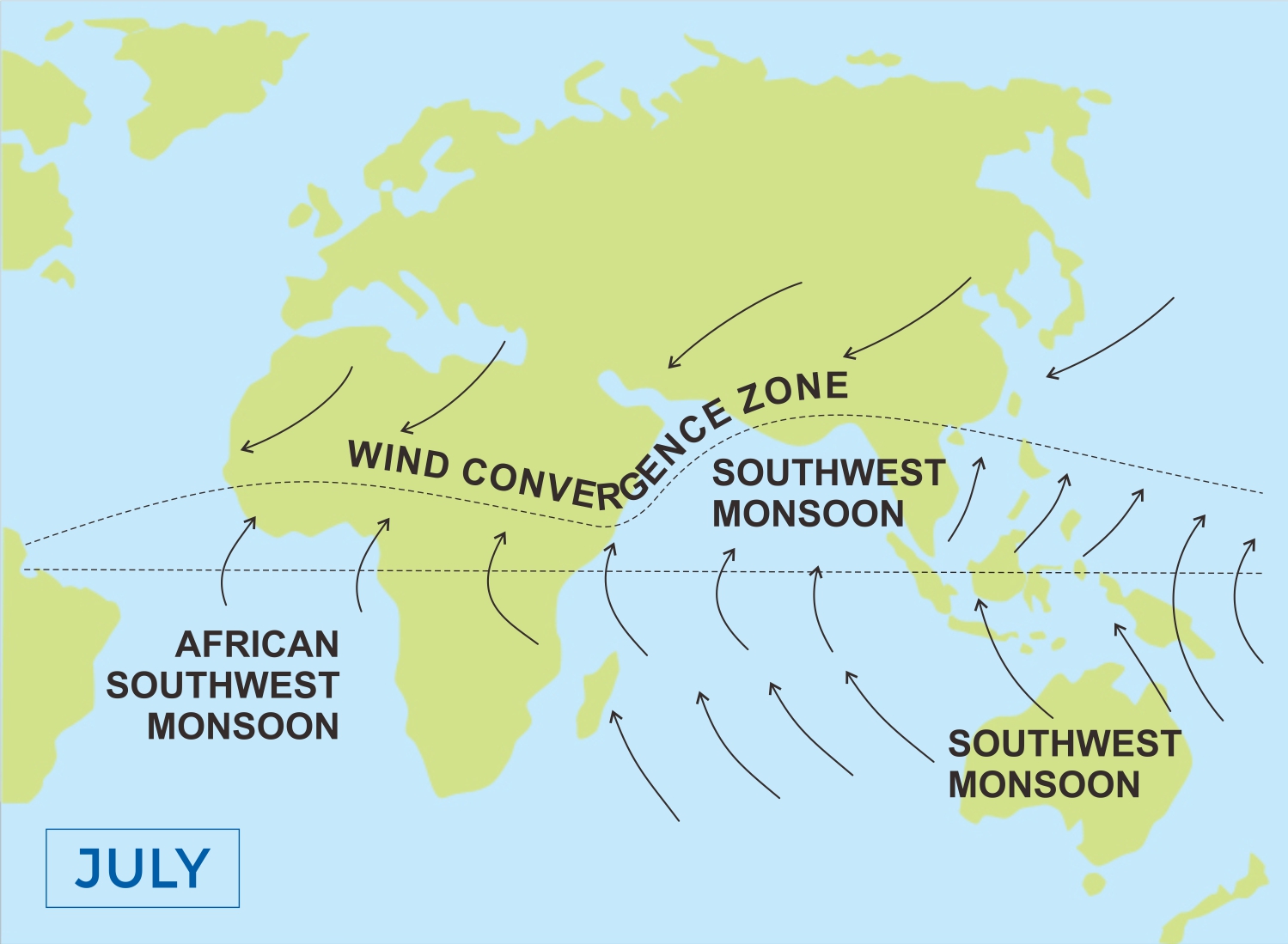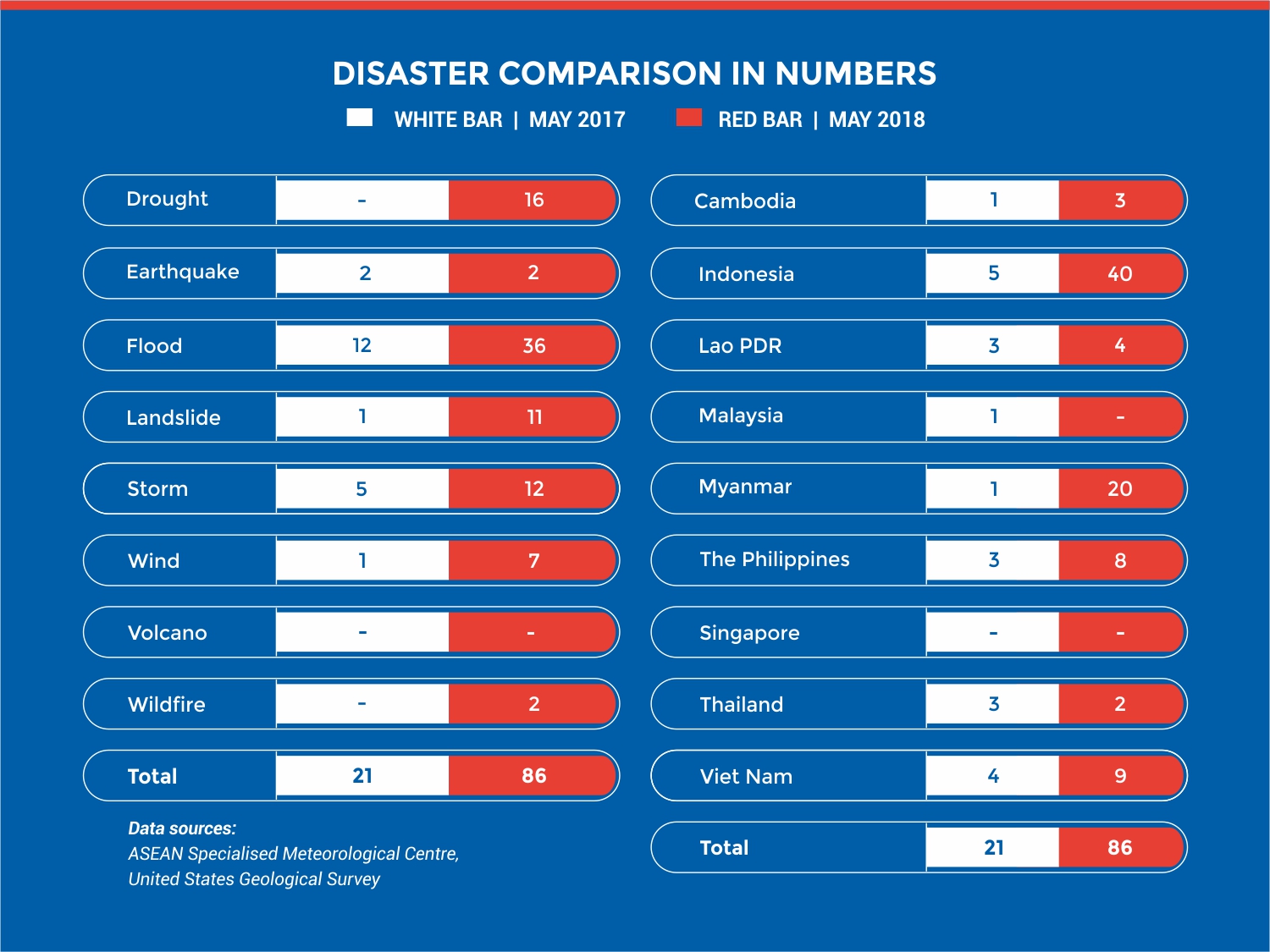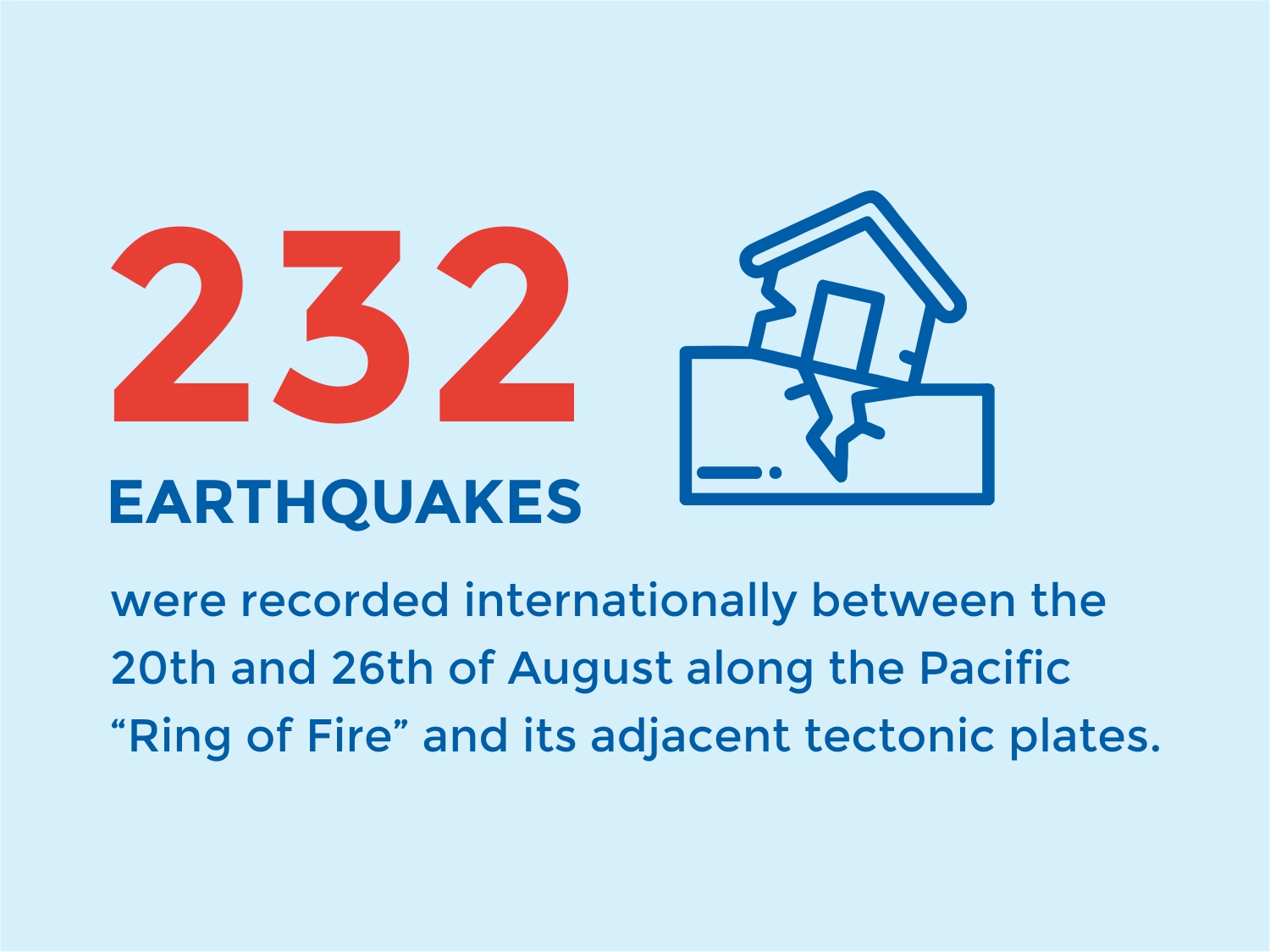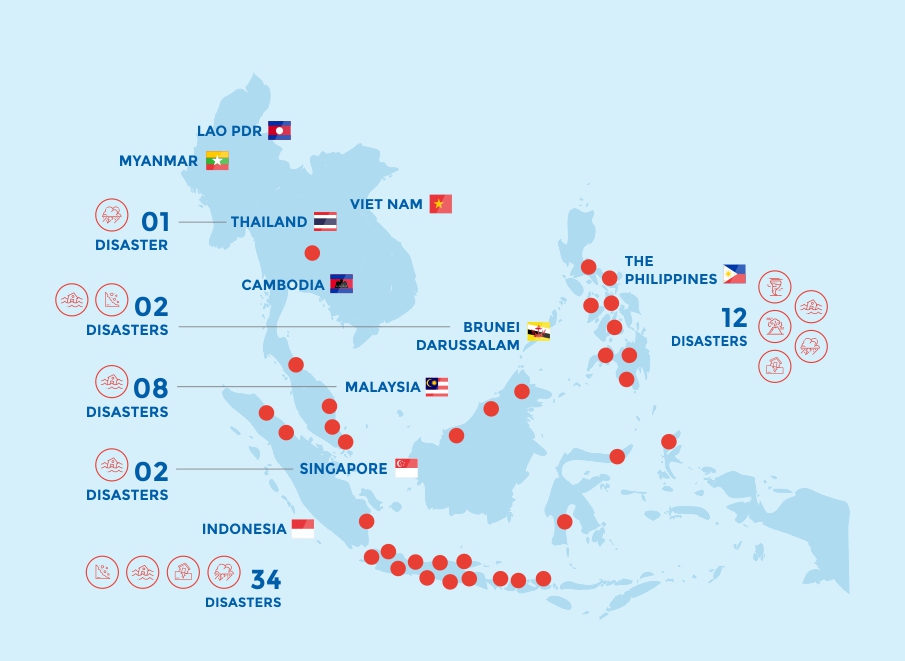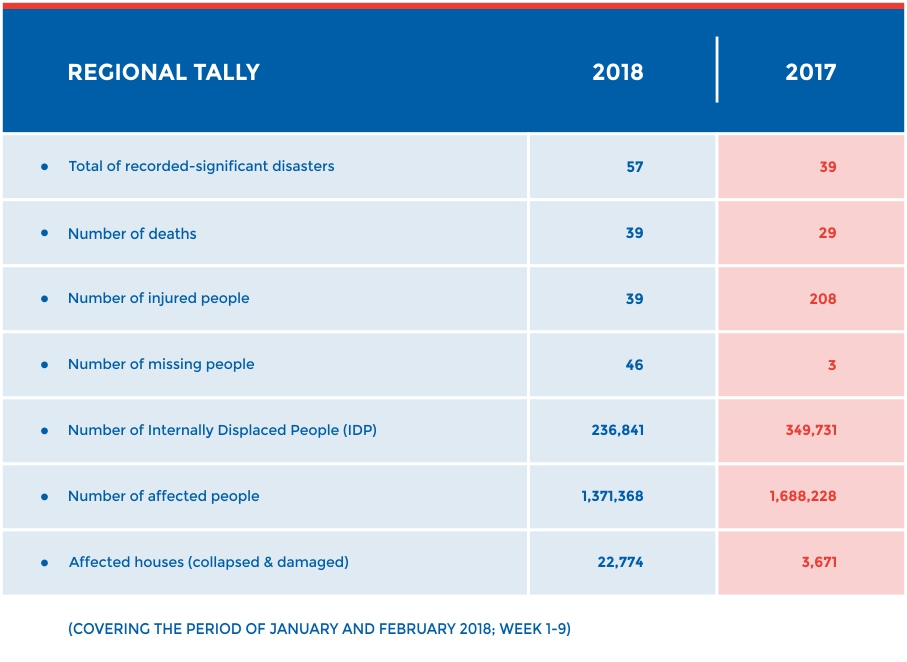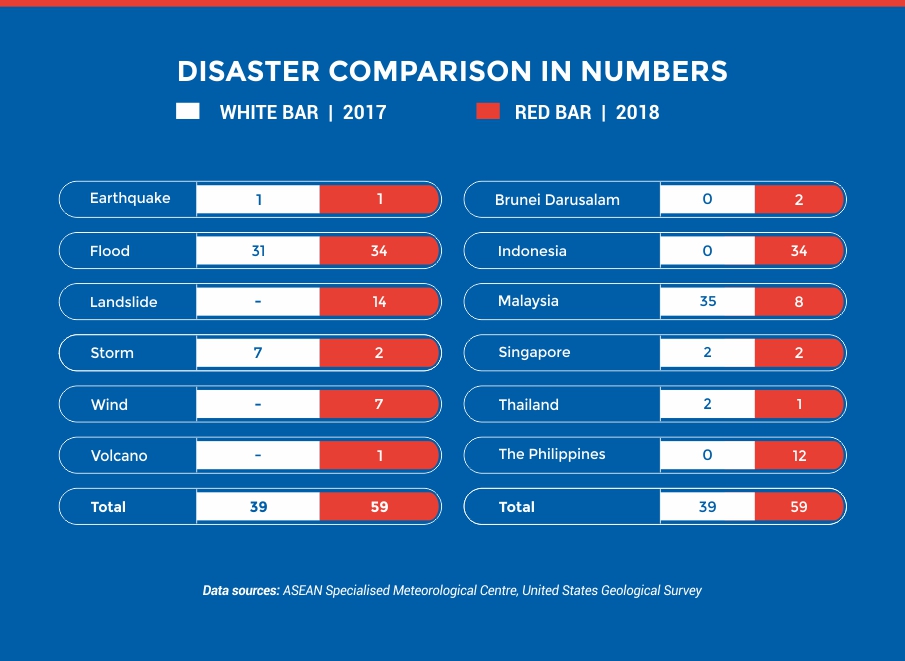Vol 48-Monthly Disaster Review and Outlook

MONTHLY DISASTER REVIEW AND OUTLOOK
FEBRUARY 2019 | DISASTER MONITORING & ANALYSIS
(DMA) UNIT, AHA CENTRE
GENERAL OVERVIEW OF FEBRUARY 2019
February 2019 was characterised by an unusually low number of recorded disaster events, registering less than a quarter of the five-year average of occurrences for the month. Although the region experienced scattered rain showers in the south, and generally dry and hazy conditions in the north, the record-breaking low number of impact on communities (only 6% and 1% of the five-year average number for affected and displaced people respectively) could reflect the improving effectiveness of disaster management practices among ASEAN Member States. On the other hand, the recorded number of damaged houses was more than five times the five-year average. An overwhelming majority of the damage was caused by hailstorms and strong winds in Northeastern Viet Nam. Fortunately, about 84% (or 3,436) houses incurred only minor damage. In general, February 2019 was a more settled month for disaster managers across the region.
In addition to Indonesia’s South Solok Regency earthquake that resulted to minor damages, there were 30 other earthquakes of magnitude 5.0 and above in Indonesia and the Philippines during February. While still a high number, it forms only 48% compared to last month’s seismic activities of the same strength. There was also intensified dynamicity in volcanic activities in the region, most notably in Indonesia. Fortunately, only Mt. Karangetang (on Siau Island) experienced damage, which was also considered minor. This result is influenced by the increasing awareness of both authorities and communities to volcano-related risks, and their improved cooperation to mitigate and prevent impacts and damages.
SEASONAL OUTLOOK
The ASEAN Specialised Meteorological Centre reported that the prevailing Northeastern Monsoon season is expected to transition into the inter-monsoon period by the end of March 2019. During the inter-monsoon period, the region is expected to experience an increase in rain activity. This is good news for the Mekong sub-region, as it will help ease transboundary smoke haze in the area. However, this could also mean flooding, rain-induced landslides, and other hydrological hazards in the equatorial and southern parts of the ASEAN region – particularly in Indonesia and Malaysia. There remains a likelihood that the hotspots and smoke haze conditions in the Mekong sub-region could persist, however, it is expected that the prevailing dry season in northern ASEAN will gradually come to an end by April 2019.
With the expected increase in hydro-meteorological activities within the region, the AHA Centre is preparing by strengthening efforts to share early-warning information, and monitoring data and information between the Centre and National Disaster Management Organisations (NDMOs). This is being undertaken through conducting an ASEAN Workshop on Disaster Reporting and Big Data for Disaster Management, and the development of the proposed AHA Centre Information Management Technical Working Group (AIM-TWG). The workshop aims to build regional and national capacity in utilising current and new information and communication technologies, while AIM-TWG is envisioned to be a platform for cooperation and collaboration between and among AHA Centre and NDMOs for strengthening regional and national disaster information management capacities, capabilities, and practices.
Written by : Eviana Rosida, Lawrence Anthony Dimailig
DISCLAIMER
Disclaimer: AHA Centre’s estimation is based on data and information shared by National Disaster Management Organisations (NDMOs) and other relevant agencies from ASEAN Member States, international organisations and news agencies. Further information on each recorded-significant disaster, description and detail of data and information are available at: http://adinet.ahacentre.org/reports.
- Published in Monthly Disaster Outlook
Vol 48-Monthly Disaster Review and Outlook

MONTHLY DISASTER REVIEW AND OUTLOOK
DECEMBER 2018 | DISASTER MONITORING & ANALYSIS
(DMA) UNIT, AHA CENTRE
GENERAL OVERVIEW OF DECEMBER 2018
As generally expected for the “winter” or Northeast monsoon period, the southern part of ASEAN – particularly Indonesia, Malaysia, southern Philippines and Thailand – experienced an increase in floods during December 2018. Some areas within those countries also experienced landslides due to heavy rainfall in mountainous areas.
In terms of geological hazards, 32 earthquakes of magnitude 5.0 or higher were reported in December, compared to 18 earthquakes recorded during December of 2017. However, none of the recorded seismic activities had significant effects to constitute a disastrous event. A M7.2 earthquake with a deep epicentre of 60 km below the earth’s surface was also reported near Davao Oriental, the Philippines, which triggered a tsunami warning – although the warning was eventually cancelled. In general, there were no fatalities or significant damage directly caused by earthquakes this month. However, there was one undetected tsunami event in Sunda Strait that caused significant number of fatalities and damage in Banten and Lampung Provinces of Indonesia. The tsunami, that struck on the evening of December 22, was triggered by landslide on Mount Anak Krakatau, that resulted from a series of eruptions and general increased volcanic activity on the mountain that sits in the middle of the Sunda Strait. From post-event observations, Mt. Anak Krakatau was found to have reduced in height from 1,800 metres to 357 metres, based on pre and post-tsunami images released by the Indonesian Agency for the Assessment and Application of Technology (BPPT). Consequently, the Centre for Volcanology and Geological Disaster Mitigation (PVMBG) elevated the alert status from advisory to watch (level III out of maximum IV).
OUTLOOK FOR JANUARY 2019
In the first week of the fortnight, a northeast monsoon surge is expected to cause wetter conditions in the South China Sea, particularly over coastal Thailand and Viet Nam. Related stronger monsoonal winds are likely to bring wetter weather to areas around the Java Sea as well. Conversely, drier conditions are expected over the Philippines. According to PAGASA climatology of tropical cyclones, there is a possibility of up to one tropical cyclone passing through the Philippines in January. Colder conditions in the highlands of the northern ASEAN region are forecasted. Following the cold conditions in the first week, should there be a sudden drop in temperatures, it might result in increased risk of flash floods with melting of snow or increased precipitation in the highlands.
Later in the month, the wetter conditions over the South China Sea are likely to spread further southward to affect the north-eastern coast of Peninsular Malaysia and southern Thailand. Thunderstorms are expected near the equatorial belt as the trade winds will bring heavier rainfall across the South China Sea towards Peninsular Malaysia and Singapore from the eastern front. Areas around the Java Sea are likely to become drier during this period.
The prevailing Northeast Monsoon is expected to persist until March 2019. This will bring occasional extended periods of dry weather in the northern ASEAN region during this period. Tropical storms and depressions will generally pass through Central and Southern Philippines, and towards Central and Southern Viet Nam bringing heavier rainfall in these regions. Cold spells will also be common in the northern lowland provinces of Viet Nam.
Written by : Qing Yuan Pang
DISCLAIMER
Disclaimer: AHA Centre’s estimation is based on data and information shared by National Disaster Management Organisations (NDMOs) and other relevant agencies from ASEAN Member States, international organisations and news agencies. Further information on each recorded-significant disaster, description and detail of data and information are available at: http://adinet.ahacentre.org/reports.
- Published in Monthly Disaster Outlook
Vol 47-Monthly Disaster Review and Outlook

MONTHLY DISASTER REVIEW AND OUTLOOK
JANUARY 2019 | DISASTER MONITORING & ANALYSIS
(DMA) UNIT, AHA CENTRE
GENERAL REVIEW OF JANUARY 2019
Statistics of recorded significant disasters in January 2019 are significantly below the average for the previous five-years during the same period. While January saw the ASEAN region only registered a little over half of the number of disasters, as well as significantly lower numbers of affected and internally displaced people, the number of casualties and damaged houses were notably much higher than the previous five-year average, with an almost two-fold number of casualties, and twenty times the number of damaged houses. These high numbers were primarily caused by flooding and rain-induced landslide incidents in South Sulawesi, Indonesia. This unfortunate event was a result of the combination of the prevailing Northeast Monsoon and Tropical Cyclone Riley in Australia, which pulled large masses of rain clouds over several parts of Indonesia.
The number of hydro-meteorological disasters is to be expected for this time of year, and influenced a majority of registered situations. Also as expected, due to the effects of the prevailing Northeast Monsoon, the affected areas were mainly found in the equatorial and southern parts of the ASEAN region. Meanwhile, the northern area is experiencing dry conditions, resulting in haze and hotspot situations. In terms of geophysical hazards, there were 65 recorded earthquakes with a magnitude 5.0 and above during January, and several activities reported on active volcanoes in Indonesia and the Philippines. Fortunately, although there were notable incidents such as the M6.7 earthquake in West Sumba Regency and the eruption of Mt Agung, both in Indonesia, there were no significant effects that constituted a disaster situation.
SEASONAL OUTLOOK
The ASEAN Specialised Meteorological Centre is expecting the Northeast Monsoon to persist until March, before entering into the inter-monsoon period in April. With this seasonal setting, the southern parts of the region will continue to experience scattered rain showers, while the northern areas will continue to experience dry conditions. Flood and rain-induced landslides will continue to be threats in the equatorial and southern parts, especially in areas where above-normal rainfall is expected – such as Malaysia, Sumatra, and Kalimantan. The continuous dry conditions and the expected above-normal temperatures in the north will likely exacerbate haze and hotspot situations, especially in the Mekong sub-region (see Figure 1).
Figure 2. The Rainfall and Temperature Outlook for the first half of February displays dry and warm conditions for some areas in the northern part of the region. Similar effects, with possible difference in spatial distribution, are expected to continue until March due to the Northeast Monsoon.
With these potential incidents, the AHA Centre is strengthening its Disaster Monitoring and Analysis Unit through an internship programme. Successful interns will help the Centre in monitoring hazards throughout the region on a daily basis, preparing necessary datasets, and analysing disaster events to support decision-making and drive actions.
Data Sources: ASEAN Disaster Information Network, ASEAN Specialised Meteorological Centre
Written by : Lawrence Anthony Dimailig
DISCLAIMER
AHA Centre’s estimation is based on data and information shared by National Disaster Management Organisations (NDMOs) and other relevant agencies from ASEAN Member States, international organisations and news agencies. Further information on each recorded-significant disaster, description and detail of data and information are available at: http://adinet.ahacentre.org/reports.
- Published in Monthly Disaster Outlook
Vol 46-Monthly Disaster Review and Outlook

MONTHLY DISASTER REVIEW AND OUTLOOK
DECEMBER 2018 | DISASTER MONITORING & ANALYSIS
(DMA) UNIT, AHA CENTRE
GENERAL OVERVIEW OF DECEMBER 2018
As generally expected for the “winter” or Northeast monsoon period, the southern part of ASEAN – particularly Indonesia, Malaysia, southern Philippines and Thailand – experienced an increase in floods during December 2018. Some areas within those countries also experienced landslides due to heavy rainfall in mountainous areas.
In terms of geological hazards, 32 earthquakes of magnitude 5.0 or higher were reported in December, compared to 18 earthquakes recorded during December of 2017. However, none of the recorded seismic activities had significant effects to constitute a disastrous event. A M7.2 earthquake with a deep epicentre of 60 km below the earth’s surface was also reported near Davao Oriental, the Philippines, which triggered a tsunami warning – although the warning was eventually cancelled. In general, there were no fatalities or significant damage directly caused by earthquakes this month. However, there was one undetected tsunami event in Sunda Strait that caused significant number of fatalities and damage in Banten and Lampung Provinces of Indonesia. The tsunami, that struck on the evening of December 22, was triggered by landslide on Mount Anak Krakatau, that resulted from a series of eruptions and general increased volcanic activity on the mountain that sits in the middle of the Sunda Strait. From post-event observations, Mt. Anak Krakatau was found to have reduced in height from 1,800 metres to 357 metres, based on pre and post-tsunami images released by the Indonesian Agency for the Assessment and Application of Technology (BPPT). Consequently, the Centre for Volcanology and Geological Disaster Mitigation (PVMBG) elevated the alert status from advisory to watch (level III out of maximum IV).
OUTLOOK FOR JANUARY 2019
In the first week of the fortnight, a northeast monsoon surge is expected to cause wetter conditions in the South China Sea, particularly over coastal Thailand and Viet Nam. Related stronger monsoonal winds are likely to bring wetter weather to areas around the Java Sea as well. Conversely, drier conditions are expected over the Philippines. According to PAGASA climatology of tropical cyclones, there is a possibility of up to one tropical cyclone passing through the Philippines in January. Colder conditions in the highlands of the northern ASEAN region are forecasted. Following the cold conditions in the first week, should there be a sudden drop in temperatures, it might result in increased risk of flash floods with melting of snow or increased precipitation in the highlands.
Later in the month, the wetter conditions over the South China Sea are likely to spread further southward to affect the north-eastern coast of Peninsular Malaysia and southern Thailand. Thunderstorms are expected near the equatorial belt as the trade winds will bring heavier rainfall across the South China Sea towards Peninsular Malaysia and Singapore from the eastern front. Areas around the Java Sea are likely to become drier during this period.
The prevailing Northeast Monsoon is expected to persist until March 2019. This will bring occasional extended periods of dry weather in the northern ASEAN region during this period. Tropical storms and depressions will generally pass through Central and Southern Philippines, and towards Central and Southern Viet Nam bringing heavier rainfall in these regions. Cold spells will also be common in the northern lowland provinces of Viet Nam.
Written by : Qing Yuan Pang
DISCLAIMER
Disclaimer: AHA Centre’s estimation is based on data and information shared by National Disaster Management Organisations (NDMOs) and other relevant agencies from ASEAN Member States, international organisations and news agencies. Further information on each recorded-significant disaster, description and detail of data and information are available at: http://adinet.ahacentre.org/reports.
- Published in Monthly Disaster Outlook
Vol 45-Monthly Disaster Review and Outlook

MONTHLY DISASTER REVIEW AND OUTLOOK
NOVEMBER | DISASTER MONITORING & ANALYSIS
(DMA) UNIT, AHA CENTRE
GENERAL OVERVIEW OF NOVEMBER 2018
November 2018 witnesses a two-fold increase in flood occurrences reported in comparison to the same period during 2017. As the region enters the “winter” monsoon period, the southern parts of ASEAN generally experience heavier rainfall, particularly in areas around the equator (shown in Figure 1) where precipitation patterns are generally higher. The heavier precipitation patterns (darker blue areas) are also brought about by typhoons and tropical storms, with these hydro-meteorological phenomena contributing to the increased flooding and collateral hazards (e.g. landslides) reported in the last month. An interesting note is that there was still drought reported in Indonesia – although this is coming to an end as the rainy season approaches.
In terms of geological hazards, 20 earthquakes of higher than magnitude 5.0 were reported during November 2018, compared to 22 during November 2017. Even though there were fewer reported earthquakes in 2018, the earthquakes were widely distributed across the boundary of the Indo-Australian plate, compared to being concentrated in the Ambon Sea in November 2017. Of concern are that 45% of these earthquakes were registered with a depth of less than 20km, which increases the likelihood of damage and disaster in nearby communities. In 2018, the reported earthquakes mostly occurred in areas with higher vulnerability – including in Eastern Indonesia and southern parts of the Philippines. There are currently six active volcanoes in Indonesia (Krakatau, Merapi, Agung, Semeru, Ibu and Dukono), as well as one in the Philippines (Mayon) on which recent volcanic activity has been reported.
OUTLOOK FOR THE DECEMBER 2018 – FEBRUARY 2019 PERIOD
There is an increased probability of above-average rainfall over the western equatorial region (parts of northern Sumatra, Peninsular Malaysia and Borneo). During this season, the monsoon rain band is forecasted to gradually shift south towards the Equator with an increased likelihood of shower activities and winds of light and variable direction. Shower activities are expected to persist until January 2019, reducing in the approach to February. Due to rainy conditions, hotspot activities in the southern ASEAN region are likely to remain activities in the southern ASEAN region are likely to remain subdued. Collateral hazards to heavy rains, such as landslides, should be monitored during this period, as heavier precipitation may trigger isolated incidents in hilly or mountainous areas.
Modeling has indicated that tropical Pacific Ocean sea surface temperature anomalies are not expected to warm much further. The probability of weak El Niño conditions occurring will peak during the October-December 2018 season, and will weaken beyond the first quarter of 2019. Due to the weak El Niño conditions, tropical typhoon forecasts remain at up to 3 potential typhoons until January 2019, with a slim chance of any forming during February*.
*) Information courtesy of the Philippine Atmospheric, Geophysical and Astronomical Services Administration (PAGASA).
Written by : Qing Yuan Pang
DISCLAIMER
AHA Centre’s estimation is based on data and information shared by National Disaster Management Organisations (NDMOs) and other relevant agencies from ASEAN Member States, international organisations and news agencies. Further information on each recorded-significant disaster, description and detail of data and information are available at: http://adinet.ahacentre.org/reports.
- Published in Monthly Disaster Outlook
Vol 44-Monthly Disaster Review and Outlook

MONTHLY DISASTER REVIEW AND OUTLOOK
NOVEMBER | DISASTER MONITORING & ANALYSIS
(DMA) UNIT, AHA CENTRE
GENERAL OVERVIEW OF
OCTOBER 2018
Compared to 2017, the number of disasters reported for the same period is almost the same for the inter-monsoon season. Hydro-meteorological disasters are still the highest in number, but mostly within the central region of ASEAN. Heavier rain was experienced around the Malaysian Peninsula and Northern Sumatra, which caused floods and resultant landslides. Despite being localised, the amount of damage sustained was significant, but less if compared to the same period last year. On the other hand, the seismic activity remains of significant concern, with a total of 28 earthquakes of magnitude 5 and above reported in ASEAN during October 2018 (compared to 12 in 2017). Most of the recorded earthquakes occurred around Central Sulawesi, Indonesia, which is located along a large fault line. Public and relevant authorities may wish to exercise more caution, and increase mitigation and reduction risk activities related to geophysical disasters
OUTLOOK FOR THE OCTOBER TO DECEMBER 2018 PERIOD
(SEASONAL FORECAST FROM ASEAN SPECIALISED METEOROLOGICAL CENTRE)
The Southwest Monsoon season is expected to transition into the inter-monsoon period around mid-October, and persist for some weeks before giving way to the Northeast Monsoon season in late-November/December.
During the changeover, the prevailing south-easterly or south-westerly winds are expected to gradually weaken to become light and variable in direction, with a gradual strengthening of north-easterly winds to be expected. Characteristically, this is accompanied by a southward shift of the monsoon rain-band, which will bring more rainfall over the southern ASEAN region. The northern ASEAN region will experience decreased rainfall as the season progresses.
Above-normal temperature conditions are expected over many parts of the ASEAN region, especially in the equatorial regions during the coming months. In the northern ASEAN region, occasional hotspots may emerge as drier conditions set-in toward the later part of the season.
In the southern ASEAN region, brief periods of dry weather may contribute to increased hotspot activities in October, which may lead to an occurrence of transboundary haze affecting some parts of the region. However, an increase in shower activities with the onset of the inter-monsoon period will help subdue hotspot activities.
The outlook is assessed for the region in general. For specific updates on the national scale, the relevant National Meteorological and Hydrological Services of ASEAN Member States should be consulted.
Written by : Mizan Bisri, Qing Yuan Pang
DISCLAIMER
Disclaimer: AHA Centre’s estimation is based on data and information provided by National Disaster Management Organisations (NDMOs) and other relevant agencies from ASEAN Member States, international organisations and news agencies. Further information on each recorded-significant disaster, description and detail of data and information are available at: http://adinet.ahacentre.org/reports.
- Published in Monthly Disaster Outlook
Vol 43-Monthly Disaster Review and Outlook

MONTHLY DISASTER REVIEW AND OUTLOOK
SEPTEMBER | DISASTER MONITORING & ANALYSIS
(DMA) UNIT, AHA CENTRE
GENERAL OVERVIEW OF SEPTEMBER 2018
With the Northwest Monsoon season coming to an end between late September and early October, weather patterns in northern ASEAN will shift from wet with heavy rainfall towards a drier and cooler climate. Occasional storms and thunderstorms may still cause flash floods within certain parts of northern ASEAN. During September, the Philippines experienced Super Typhoon Mangkhut, which passed through the nation’s Northern regions and islands around the vicinity. The typhoon brought about heavy rainfall and triggered deadly landslides, causing significant destruction and devastation to agricultural crops. However, as a result of the changing trade winds, the cyclone season is returning, with increased vigilance required as the likelihood of cyclone formation increases in the Bay of Bengal.
A large number of earthquakes have been recorded throughout the past 2 months. The increased seismic activity has not only been occurring within the region, but also on a global scale. During Week 34 of 2018 (from the 20th to the 26th of August), a total of 232 earthquakes were recorded across the Pacific “Ring of Fire” and its adjacent tectonic plates. Of these recorded earthquakes, 37 (15.9%) were recorded to be M 5.0 and above. Of these major earthquakes (≥M 5.0), 25 (67.6%) occurred within a 48-hour period between the 20th and 22nd of August. Of the 232 earthquakes across the world, 32 (13.8%) were reported within ASEAN region, of which 11 (34.4%) were reported to be M 5.0 and above. The overall increase in seismic activity is currently being monitored by seismological agencies, in the anticipation of increased volcanic activity, earthquakes, tsunamis and other resultant hazards. Nevertheless, during the last few months, the activity of volcanoes in the Philippines and Indonesia have remained within their normal threshold, and have experienced no changes to any of their alert levels.
OCTOBER 2018 OUTLOOK (FORECAST FROM
THE ASEAN SPECIALISED METEOROLOGICAL CENTRE)
The Southwest Monsoon season is expected to transition to the inter-monsoon period around mid-October, and persist for some weeks before giving way to the Northeast Monsoon season in late-November/December.
During the coming weeks, the prevailing south-easterly or south-westerly winds are expected to gradually weaken to become light and variable in direction. A gradual strengthening of north-easterly winds can be expected in the later part of the Oct-Nov-Dec (OND) season. Characteristically, this is accompanied by a southward shift of the monsoon rain-band, which will bring more rainfall over the southern ASEAN region. The northern ASEAN region will experience lighter rainfall as the season progresses, while in equatorial areas, below-average rainfall is forecast to continue for October. Temperature-wise, above-average conditions are expected over many parts of ASEAN, with warmer-than-average conditions expected over the equatorial ASEAN – particularly in Borneo and south-eastern Sumatra.
In northern ASEAN, occasional hotspots may emerge as drier conditions set in toward the later part of the OND season, however, should remain subdued in the early parts due to wet weather. In southern ASEAN, brief periods of dry weather may contribute to increased hotspot activities in October. This could lead to an occurrence of transboundary haze affecting some parts of the region. However, an increase in shower activities with the onset of the inter-monsoon period will help subdue hotspot activities. Isolated hotspots may develop occasionally, but these hotspots are expected to be short-lived and localised. In equatorial ASEAN, drier-than-usual weather could to lead to an escalation in hotspot activities and an increased risk of trans-boundary smoke haze.
The outlook is assessed for the region in general. For specific updates on the national scale, the relevant ASEAN National Meteorological and Hydrological Services as well as Geological Services of ASEAN countries should be consulted.
Written by : Mizan Bisri, Qing Yuan Pang
DISCLAIMER
AHA Centre’s estimation is based on data and information shared by National Disaster Management Organisations (NDMOs) and other relevant agencies from ASEAN Member States, international organisations and news agencies. Further information on each recorded-significant disaster, description and detail of data and information are available at: http://adinet.ahacentre.org/reports.
- Published in Monthly Disaster Outlook
Vol 42-Monthly Disaster Review and Outlook

MONTHLY DISASTER REVIEW AND OUTLOOK
JULY & AUGUST | DISASTER MONITORING & ANALYSIS
(DMA) UNIT, AHA CENTRE
GENERAL OVERVIEW OF JULY AND AUGUST 2018
A two-week period in July saw the development of 5 tropical storms, one of which had a severe affect on the northern ASEAN region. The Southwest monsoon (refer to figure 1.) brought with it heavy torrential rains, resulting in flooding through the Mekong River region. Hydro-meteorological disasters formed the main hazards during this period, and are expected to persist with continued rain over the northern ASEAN region, coupled with drier conditions in southern part of ASEAN.
In contrast to the situation in the northern ASEAN region, droughts in 16 municipalities have been reported across seven consecutive weeks thus far, with one reported wildfire occurrence in the past month. The ASEAN Specialised Meteorological Centre detected hotspots in Indonesia’s Kalimantan and Sumatra during July. General conditions for August remained similar to July, with high rainfall experienced over the northern region, impacting countries in the Mekong region and northern parts of the Philippines.
Throughout the last 2 months, large numbers of earthquakes were recorded and experienced by ASEAN communities. The increased seismic activity is not only restricted to the region,with the phenomenon also seen globally. A total of 232 earthquakes were recorded internationally between the 20th and 26th of August along the Pacific “Ring of Fire” and its adjacent tectonic plates. Of these recorded earthquakes, 37 (15.9%) were recorded at a scale of M 5.0 or above, with 25 (67.6%) of these major earthquakes (≥M 5.0) occurring within a span of 48 hours between August 20th to 22nd. Of these 232 earthquakes, 32 (13.8%) were reported within the ASEAN region. Of the 32 recorded in the region, 11 (34.4%) were reported to be M 5.0 and above. The increasing seismic activity is currently being observed by seismological agencies in anticipation of increased volcanic activity, earthquakes, tsunamis and other related hazards. Nevertheless, in July and August 2018, activity of volcanoes in Philippines and Indonesia stayed within their normal threshold, with no changes in any of their alert levels
The prevailing Southwest Monsoon season is expected to persist until October 2018, with prevailing winds in the region blowing from the southeast or southwest. Climatologically, the Southwest Monsoon season is characterised by rainy conditions in the northern ASEAN region, and dry conditions in the southern ASEAN region.
OUTLOOK FOR AUGUST-OCTOBER 2018
Warmer than average conditions can be expected over the equatorial ASEAN region, especially in Borneo and south-eastern Sumatra, while near-average or slightly above-average temperatures are forecasted over most other areas during the August-October season.
For the equatorial ASEAN region, below-average rainfall is forecasted between August and October. The drier-than-usual weather could to lead to an escalation in hotspot activities and an increased risk of transboundary smoke haze.
Near-average rainfall is forecasted for the rest of the region, including the northern ASEAN region. Hotspot activities in the northern ASEAN region are likely to remain subdued due to wet weather. The outlook is assessed for the region in general. For specific updates on the national scale, the relevant National Meteorological and Hydrological Services as well as Geological Services should be consulted.
Written by : Mizan Bisri, Qing Yuan Pang
DISCLAIMER
AHA Centre’s estimation is based on data and information shared by National Disaster Management Organisations (NDMOs) and other relevant agencies from ASEAN Member States, international organisations and news agencies. Further information on each recorded-significant disaster, description and details of data and information are available at: http://adinet.ahacentre.org/reports.
- Published in Monthly Disaster Outlook
Vol 36-Monthly Disaster Outlook

MONTHLY DISASTER REVIEW OUTLOOK
JANUARY AND FEBRUARY 2018 | DISASTER MONITORING & ANALYSIS
(DMA) UNIT, AHA CENTRE
GENERAL OVERVIEW OF JAN AND FEB 2018
Between January and February 2018, a total of 57 disasters were reported from within ASEAN Member States. Due to the higher-than-average rainfall; 57.8% of all disasters reported in this period are attributed to floods. In addition, landslides are of major concern in areas prone to slope failure which potentially cause disruptions and significant damage to major circulatory transport systems, as well as impacting communities and trade. In the northern ASEAN region, record-low temperatures have been reported during this winter season, with storms recorded in Viet Nam, Thailand and Cambodia. Whereas the emergency response operation for Typhoon Tembin was extended until the third week of January, additional impact of Tropical Storm Sanba (Basyang) affected more than two hundred-thousand people in the Philippines.
Earthquakes and volcanic activity remain high on the agenda, with two significant earthquakes observed in the region. A magnitude 6.1 earthquake occurred on the 23rd of January 2018, affecting provinces of Banten, West Java and Jakarta in Indonesia. Although there were over seven thousand homes damaged, the emergency response was managed well by the Indonesian authorities. More recently, a magnitude 7.6 earthquake was recorded in Papua New Guinea on February 26th, with tremors felt and light damage caused in several regencies of the Papua Province (Indonesia). The earthquake was followed by 53 strong aftershocks (M 5.0 and above) within the following week, without additional damage experienced in any parts of Indonesia. Also in Indonesia, the situation on Mount Agung, Bali, has greatly improved, with its alert level being lowered, and its mandatory exclusion zone relaxed. In the Philippines, Mount Mayon’s Phreatomagmatic Eruption, has been ongoing throughout January & February. This activity has affected the daily lives of more than 90,000 people in the Albay Province, yet there have been no human casualties reported, showcasing the result of effective preparedness and response.
OUTLOOK FOR MARCH AND APRIL 2018
ASEAN Specialised Meteorological Centre (ASMC) has forecasted that during the coming months, the region will begin a gradual transition from the current Northeast Monsoon season to the inter-monsoon period. The inter-monsoon period (April and May) is a transition period that sees low-level winds in the region being generally light and variable in direction, with an increase in light rain activity expected across ASEAN during this time.
For the March-April-May 2018 season, slightly below-average to near-average rainfall is forecasted for most parts of Southeast Asia, except for the Philippines, who can expect slightly above-average rainfall during these months. During March and April, slightly above-normal rainfall is forecasted over the northern parts of Kalimantan and Sulawesi, as well as the western districts of Papua.
Written by : Mizan Bisri, Qing Yuan Pang
DISCLAIMER
AHA Centre’s estimation is based on data and information shared by National Disaster Management Organisations (NDMOs) and other relevant agencies from ASEAN Member States, international organisations and news agencies. Further information on each recorded-significant disaster, description and details of data and information are available at: http://adinet.ahacentre.org/reports.
- Published in Monthly Disaster Outlook
Vol 40-Monthly Disaster Review and Outlook

MONTHLY DISASTER REVIEW AND OUTLOOK
JUNE 2018 | DISASTER MONITORING & ANALYSIS
(DMA) UNIT, AHA CENTRE
GENERAL OVERVIEW OF JUNE 2018
There was a three-fold increase in the number of disasters recorded during June 2018 (45 in total) in comparison to the same time during 2017 (15 disasters). An onset of numerous weather events caused this spike in disasters, with the southwest monsoons, Tropical Depression (TD) Domeng, TD Ewiniar, TD Ester and TS Florita causing floods and landslides throughout the Philippines, Viet Nam and Myanmar. In contrast, several areas south of the equator, particularly Indonesia’s Central Java and Yogyakarta provinces, have experienced the onset of drought conditions, consistent with the shift to the region’s dry season. This such phenomena indicates a similar pattern to 2017, which saw northern parts of ASEAN experiencing wet season floods, while southern parts experienced dry season drought events (see Figure 1) . Overall, 20 flood events, 11 storms and 4 wind-related disasters were recorded throughout June 2018.
In terms of geological hazards, 26 earthquakes registering ≥ M 4.5 were observed across Indonesia and the Philippines. However, only two were strong enough to cause property damage (East Java and Papua provinces of Indonesia, on the 13th and 15th of June respectively. Towards the end of June 2018, concerns were raised due to increased activity reported on Bali’s Mount Agung, which released ash plumes and resulted in a strombolian-type eruption.
OUTLOOK FOR JULY-AUGUST 2018
According to the ASEAN Specialised Meteorological Centre (ASMC), most parts of the ASEAN region will continue to experience wet weather, as the rain band associated with Typhoon Prapiroon affects the region. Hotspot activities have remained subdued, but isolated events have been detected in Viet Nam and Lao PDR. During the first week of July, dry weather is expected to affect Java, and may exacerbate the ongoing drought events. Aside from such southern areas, wet weather is likely to persist over other parts of the ASEAN region. For tropical cyclone (TC) forecasts, the Philippine Atmospheric. Geophysical and Astronomical Services Administration (PAGASA) expects that 10-14 TCs will form and enter the Philippine Area of Responsibility throughout the six months between July and December 2018.
Close and continuous monitoring is still required for Mount Sinabung (Alert Level IV) and Mount Agung (Alert Level III) in Indonesia, particularly due to historic Mount Agung eruptions, which lasted up to one year during 1963-1964.
Written by : Mizan Bisri, Qing Yuan Pang
DISCLAIMER
AHA Centre’s estimation is based on data and information shared by National Disaster Management Organisations (NDMOs) and other relevant agencies from ASEAN Member States, international organisations and news agencies. Further information on each recorded-significant disaster, description and details of data and information are available at: http://adinet.ahacentre.org/reports.
- Published in Monthly Disaster Outlook

